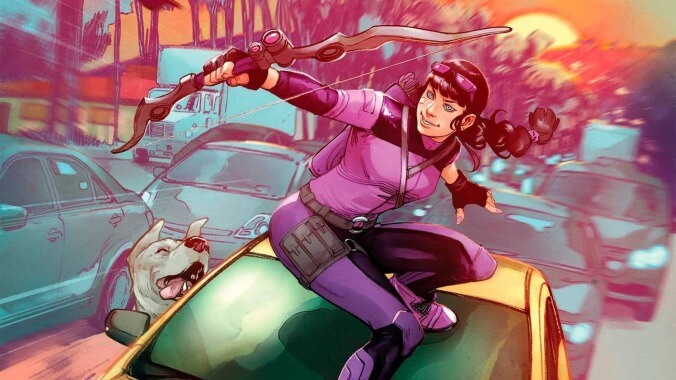Hawkeye: Kate Bishop is a step backward for the new MCU hero
The character may pop on Disney Plus' show, but Kate’s new comic miniseries retreads familiar territory


When it comes to legacy superheroes, few have done it better than Kate Bishop. She took on the Hawkeye name when she was a teenager, and she refused to let it go when her predecessor returned to prominence, forcing Clint Barton to share the Hawkeye spotlight and oftentimes operate in her shadow. She was a co-lead in one of the most stylish superhero comic runs ever—Matt Fraction, David Aja, and Annie Wu’s Hawkeye—and she’s continued to star in books that have their own distinct visual language, giving the character a truly impressive artistic pedigree.
Kate Bishop’s popularity is on the rise thanks to Hailee Steinfeld’s starring role in Disney+’s Hawkeye TV series, and her latest comic book miniseries, Hawkeye: Kate Bishop (Marvel), is designed to appeal to readers who might just be discovering Kate for the first time via the Marvel Cinematic Universe.
The book actively distances Kate from her typical supporting cast to tell a sort of homecoming story, taking her from Los Angeles to a resort in the Hamptons, where her estranged sister is waiting. Written by Marieke Nijkamp, this miniseries gives new readers an accessible gateway to Kate’s comic book adventures, but the narrative and visuals lack the strong hook of her past comics.
Nijkamp made her comics debut last year with DC’s YA graphic novel The Oracle Code, a compelling psychological thriller about a teenaged Barbara Gordon dealing with the recent trauma of a gunshot wound that left her paralyzed from the waist down. The script for Hawkeye: Kate Bishop doesn’t have that same level of emotional depth, glossing over the complications of Kate’s current circumstances to revive her conflict with her sister. This first issue opens with a slick action sequence weighed down by loads of awkward exposition as Kate uses a fight to recount her recent relationship woes, both romantic and platonic.
There’s a lot of energy in Enid Balám and Oren Junior’s linework, but the dialogue undercuts the intensity of the action. The best visual in the book comes via a two-page spread of the resort Kate is staying at in the Hamptons, presented with a bird’s-eye, X-ray view that sets the stage for the mystery to come. Unfortunately, that mystery isn’t all that interesting yet.
During a key conversation between Kate and her sister that jumps between the past and present to show where they last left off, clarity becomes an issue. The layout of square panels can be read in two different ways, either as two vertically oriented pages or a two-page spread you read row by row, and the script doesn’t distinguish those breaks clearly enough to lead the reader in the right direction. The visuals also play into this, with the colors grouping panels together in ways that lead the eye to a different place than the next step in a sequence. These elements interrupt the emotional storytelling; that’s a problem when the plot requires the reader to be invested in a strained relationship between sisters.